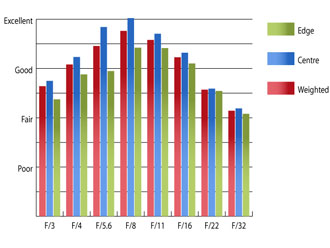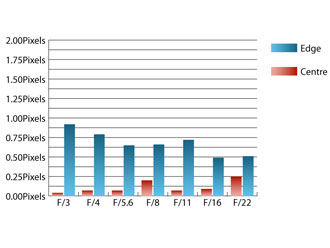Sigma 50mm f/2.8 EX DG
Sigma 50mm f/2.8 EX DG: Performance
When shot wide open, this lens produces images with fairly good sharpness in the centre and the quality towards the edges isn't far behind.As the lens is stopped down, the quality improves and peak quality across the frame is achieved at f/8, where the resolution in the centre is outstanding, and the performance towards the edges is very good.
| Resolution at 50mm | How to read our graphsThe blue column represents readings from the centre of the picture frame at the various apertures and the green is from the edges. Averaging them out gives the red weighted column.The scale on the left side is an indication of actual image resolution. The taller the column, the better the lens performance. Simple. For this review, the lens was tested on a Nikon D300 using Imatest. |
 |
Chromatic aberrations are kept within acceptable levels. They are at their worst when shooting wide open, where they can cover 0.92pixel widths. This level of fringing shouldn't cause any issues, even in large prints, or harsh crops from the edge of the frame.
| Chromatic Aberrations at 50mm | How to read our chartsChromatic aberration is the lens' inability to focus on the sensor or film all colours of visible light at the same point. Severe chromatic aberration gives a noticeable fringing or a halo effect around sharp edges within the picture. It can be cured in software.Apochromatic lenses have special lens elements (aspheric, extra-low dispersion etc) to minimize the problem, hence they usually cost more. For this review, the lens was tested on a Nikon D300 using Imatest. |
 |
Only 0.465% barrel distortion was picked up by Imatest. This is an extremely low level and shouldn't pose any issues for general use. However if your application requires this to be corrected, you'll be glad to know the distortion pattern is uniform across the frame, making it simple to correct in image editing software afterwards.
This lens dislpayed very few issues with flare or loss of contrast during use. Shooting directly into a strong light source will result in a slight loss of contrast. A circular hood is supplied with the lens, which screws into the filter thread and does a reasonable job of shielding the lens from extraneous light.
 |  | |
| Maximum magnification – ISO200, 1/125, f/11, 50mm | Low distortion – ISO200, 1/200, f/8, 50mm | |
 |  | |
| (Above) ISO280, 1/125, f/7.1, 50mm (Left) ISO500, 1/125, f/5, 50mm |
Add your message
Login required
Please login here or if you've not registered, you can register here. Registering is safe, quick and free.
Please login here or if you've not registered, you can register here. Registering is safe, quick and free.
photodo Stats
1102 lenses
428 MTF tests
74 in-depth photodo reviews
100+ users join each day
Help the lens community by reviewing or rating a lens today via our lens search
428 MTF tests
74 in-depth photodo reviews
100+ users join each day
Help the lens community by reviewing or rating a lens today via our lens search
Latest Lens Reviews
- Chinon 28mm f/2.8 Vintage Lens Review
- Canon EF 70-200mm f/4L IS II USM Lens Review
- Samyang AF 85mm f/1.4 EF Review
- Sigma 70mm f/2.8 DG Macro Art Review
- Samyang AF 24mm f/2.8 FE Review
- Meike 50mm f/1.7 Review
- Tamron 70-210mm f/4 Di VC USD Review
- Lensbaby Burnside 35mm f/2.8 Review
- Asahi Super Takumar 50mm f/1.4 Review
- Asahi Super-Multi-Coated Takumar 135mm f/3.5 Review
